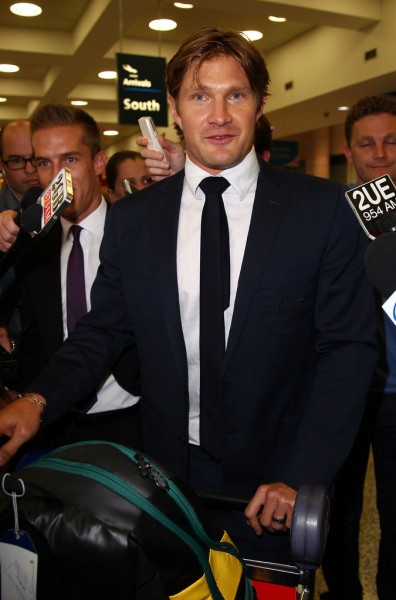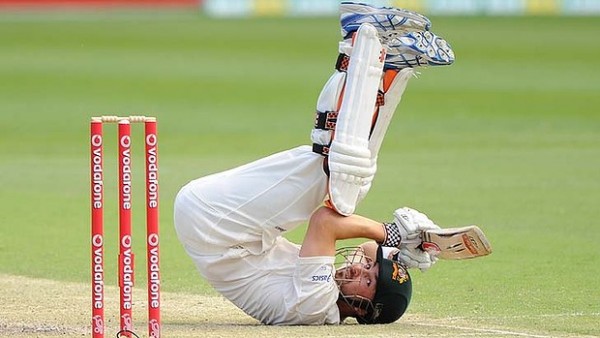
A gradual but inevitable descent into cricket-based loathing and bile.
Whatever Happened To The Unlikely Lads (International Edition)? #62: Ed Cowan
You would have to have a heart of stone to not feel a little sorry for Australian cricket fans right now. Not only are they reduced to trying to be philosophical about the inevitable recalls for the Marsh brothers, even their favorite pastime (laughing at England) has had all the fun taken out of it. For whilst England’s travails in India have been hilarious (especially Jimmy Anderson’s bitter refusal to accord the opposition any respect whatsoever), it has been tinged by the realization that, in a short few months, Australia will be there themselves. And as bad as England have been, Australia promise to be much, much, much worse. Much.

Australian tours of India = guaranteed hilarity.
At such times it can be helpful to look at past tours, to see just how bad things might get, and things could scarcely be much worse than their last tour to India in 2013. That is the tour that is most commonly remembered for Homework Gate, but to us it will always be the tour in which Glenn Maxwell not only opened the batting in a Test, but also opened the bowling too. Looking at the playing list for that tour, a few more points of interest emerge. Of course, Phil Hughes is sadly no longer with us, and it also saw the triumphant return of Steven Peter Devereux Smith to the Test playing fold. There were also brief cameos by Moises Henriques and Xavier Doherty (who took four wickets at a lazy 60.5 runs each). But the most interesting name appears right at the top of the batting order. For this is the period in which Australia’s hopes of establishing a solid start to the innings were invested in one
#62: Edward James McKenzie Cowan
Cowan emerged onto the Test scene after the shambles that was the 2010/11 Ashes, as a sort of precursor for Matt Renshaw: a solid yet limited opening bat who could potentially hold up one end whilst letting David Warner, who had made his own Test debut scarcely four weeks prior, score freely at the other. His debut innings of 68 on Boxing Day 2011 earned rave reviews. Not so much for its fluency, but rather the 177 balls Cowan occupied the crease for. Here was a solid old-fashioned opening batsman who could take the shine off the new ball and allow the attacking instincts of those around him to flourish. Or so many thought at the time.
Things hardly went swimmingly afterwards, with only one further half century in the series, at Perth, which was also utterly overshadowed by Warner down the other end, bludgeoning the Indian attack to all parts. Further poor returns in the West Indies lead to accusations that he was utterly out his depth, which, in a rare show of aggression, on or off the field, Cowan angrily disputed. Nevertheless, Cowan returned home to Australia with his position a source of fierce debate.

How could a man capable of such creativity not be fit for cricket’s greatest stage?
What followed was, by far, his greatest hour. Chasing South Africa’s first innings total of 450, Australia crumbled to 30/2, with debutant Rob Quiney falling for an expertly compiled nine (9). As Michael Clarke, in that brief patch of imperious form he enjoyed in 2012/3 before everything went to shit shortly thereafter, went about rebuilding things, Cowan put together his first, and only, Test century. Given the circumstances, a South African attack featuring Steyn, Philander, Kallis, Morkel, and, er, Rory Kleinveldt, plus the criticism he had faced beforehand, this was one of the more impressive innings by an Australian batsman in recent years.
Sadly, for Ed, he would never come anywhere near close to scaling such heights ever again. The rest of his career was blighted by false starts. Despite scoring a further three half centuries he failed to convert any of them into what might have been a career saving ton. The criticism started getting louder, and despite a solid-ish showing in India in 2013 ( where he was Australia’s second highest run-scorer), by the Ashes of that year he looked a man very much on the outer. A poor showing at Trent Bridge, where he fell for a golden duck in the first innings going for a booming drive, and for 14 in the second trying to dominate the bowling of Joe Root, sealed his fate.
The problem for Cowan was that he never looked much like a Test cricketer. This is a particularly an issue in Australia where so much stock is placed in looking the part, and young attacking cricketers are prized above all else. Hence the otherwise mystifying callup of Nic Maddinson. Once Lehmann came in it appeared only even more apparent that Cowan was a square peg in a round hole, and it was no surprise that he was the first jettisoned from the squad Lehmann inherited.

Although his Test axing happily created greater opportunities for pog-related Big Bash merchandising.
It’s interesting reading Cowan’s subsequent comments that he never considered himself to be a defensive player, only that he had adopted that role as that was what the team needed at the time. Given the obsession with “playing your natural game” that has come to define Lehmann’s tenure, it’s perhaps no surprise that the first player to be dropped was one who was prepared to sacrifice his natural instincts for the benefit of the team. Something which the Australian Test side is still only very slowly learning the benefits of, despite the numerous painful lessons handed down over recent years.
None of which, though, hides the fact that Cowan really wasn’t a very good Test batsman. Coupled with his, frankly, disturbing social habits (such as reading books, actual books, with barely any pictures in them) it’s hard to escape the conclusion that he was very lucky indeed to play as many Tests as he did. Or indeed any at all. Yet as Australia prepare for yet another almost certain humiliation on the subcontinent, the lessons provided by Cowan ought to be heeded. By putting the needs of the team first he was able to do a more than serviceable job for his country. Certainly there were many better batsmen, David Warner and Shane Watson for instance, who did much worse than he did on Australia’s last tour of India. We’re not saying a team of Ed Cowans would necessarily prove competitive (although it would be a glorious sight indeed), but it would be a hell of a lot better than a team of Nic Maddinsons.
Also his book is well worth a read.

No Comments
Post a Comment